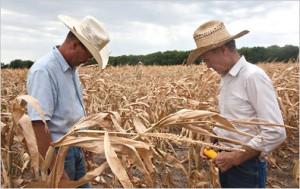DroughtDrought, heat turn hundreds of U.S. counties into disaster areas
The U.S. Agriculture Department (USDA) last week said that drought conditions and heat necessitated designating 597 counties in fourteen states as primary natural disaster areas. The affected counties have suffered severe drought for eight consecutive weeks, which qualified them for the automatic designation. 2012 had been the hottest year on record for the continental United States: the year’s average temperature of 55.3 degrees Fahrenheit across the Lower 48, which was more than 3.2 degrees warmer than the average for the twentieth century.

Drought has severely impacted U.S. agriculture // Source: tiasang.com.vn
The U.S. Agriculture Department (USDA) last week said that drought conditions and heat necessitated designating 597 counties in fourteen states as primary natural disaster areas.
“As drought persists, USDA will continue to partner with producers to see them through longer-term recovery, while taking the swift actions needed to help farmers and ranchers prepare their land and operations for the upcoming planting season,” Agriculture Secretary Tom Vilsack said in a statement.
Official designations make it possible for qualified farmers in the designated areas to receive low-interest loans, the agency said.
CNN reports that affected counties have suffered severe drought for eight consecutive weeks, which qualified them for the automatic designation.
Last year, USDA designated 2,245 counties in thirty-nine states, or 71 percent of the United States, as disaster areas due to drought.
Last week’s drought designation follows the National Oceanic and Atmospheric Administration’s (NOAA) announcement that 2012 had been the hottest year on record for the continental United States and the second-worst for “extreme” weather such as hurricanes, droughts, or floods.
The year’s average temperature of 55.3 degrees Fahrenheit across the Lower 48 was more than 3.2 degrees warmer than the average for the twentieth century, NOAA said. That topped the previous record, set in 1998, by a full degree.
The USDA says that the severe drought caused crops to shrivel across the farm belt, leading to a rise in food prices in 2013. The heat also turned forests of the mountain West into combustible tinder stands that burst into wildfires over the summer, burning millions of acres and destroying hundreds of homes.
The government begun to keep records of U.S. temperature in 1895, and NOAA notes that seven of the ten hottest years on U.S. record, and four of the hottest five, have occurred since 1990.
